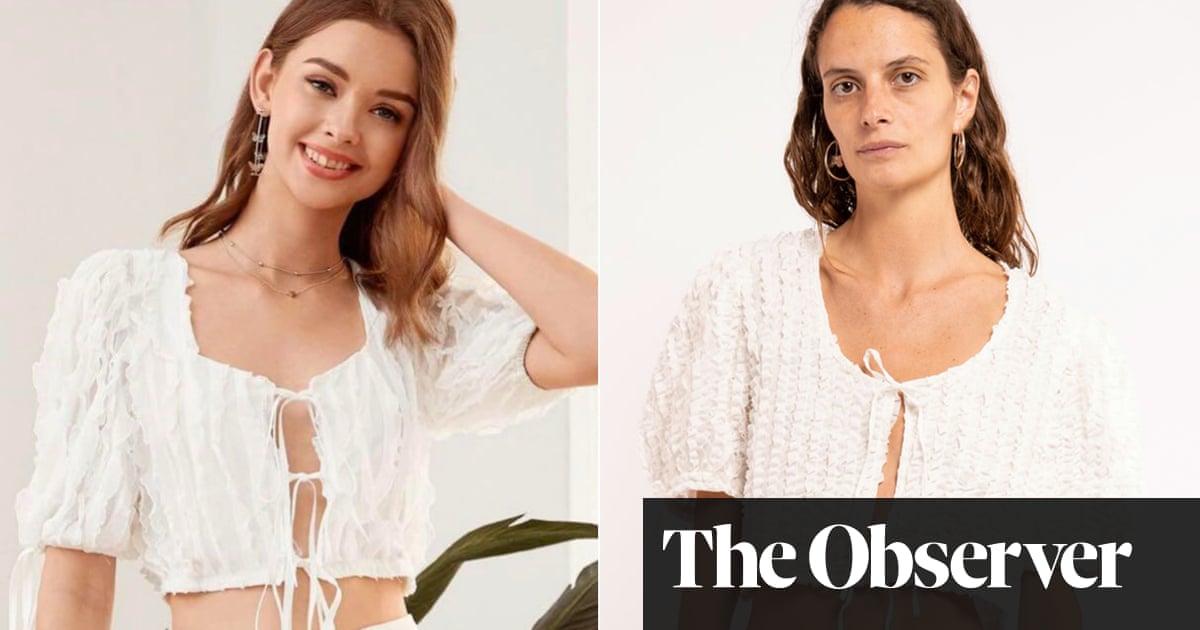
Online hyper-fast fashion company Shein was last week hit by yet another lawsuit for copyright infringement, with the latest complaint brought by accessories and apparel brand Chrome Hearts. The luxury label, which is based in LA, alleges that Shein has been selling accessories with a cross-and-dagger design that are “identical with [or] substantially indistinguishable from” its own products.
Shein, which was founded in China in 2008 and now ships its extremely cheap clothes to more than 150 countries, is fighting a growing number of copyright complaints. This July, in an unusual example of one fast-fashion retailer suing another, Swedish brand H&M filed a copyright lawsuit in Hong Kong against Shein, part of a row that has apparently been running for two years. In the same month, three independent designers, Krista Perry, Larissa Martinez, and Jay Baron, filed a suit in the US alleging that Shein sold “exact copies” of their work and that doing this is “part and parcel of Shein’s ‘design’ process and organizational DNA”.
The Observer has spoken to three other independent designers who say the fast-fashion juggernaut has stolen their designs. Approached for comment, a company spokesperson said Shein “takes all claims of infringement seriously”, adding: “It is not our intent to infringe anyone’s valid intellectual property and it is not our business model to do so.”
Shein said it had taken steps to prevent infringement, including by its suppliers and marketplace sellers. An expanded US product review team and investment in image recognition technology had, it said, led to a “double-digit percentage-point decline in infringement claims” from 2021 to 2022.
MaisonCléo
In 2019 Marie Dewet, founder of French fashion label MaisonCléo, received messages on social media from clients saying that Shein had copied some of its designs. These included its “Angèle” white off-the-shoulder blouse with three-quarter puff sleeves and ruffled cuffs, and its “Anne” off-white cropped blouse in textured fabric with bows.
Dewet was sad but “not surprised unfortunately, as it’s the way fast-fashion brands operate”. She immediately got in touch with Shein. But it was only after Diet Prada – an Instagram account with 3.4 million followers that acts as fashion watchdog – posted about the case that Shein responded and removed the pieces from its website.
Months later, Shein got back in touch, “asking if we could make a collaboration together … ‘You make the designs, we make the clothes’. I didn’t answer because they had already stolen the designs, plus I won’t ever work with a fast-fashion brand.” A few months later, more MaisonCléo designs were copied. “It’s a neverending story,” Dewet says.
The mother-and-daughter business, based in northern France, offers handmade-to-order garments using vintage fabric or surplus from French couture houses, designers or factories. Seeing a hyper-fast fashion behemoth copy their designs left Dewet “more angry about their way of producing than about them copying our designs … that’s not the main problem. The problem is the environmental and human impact they have. That is more than catastrophic and frightening. So I was more angry about this system than about the copy problem.”
She wishes more could be done to educate people about fast fashion, “because nobody is talking about this major problem to young people or to people in general while this is one of the biggest issues currently [fashion is the planet’s second-biggest polluter].” She wishes laws could be implemented to stop this happening, but concedes: “A lot of money is involved so that’s very complicated.”
Transformations by Tracy
New York-based designer Tracy Garcia first saw the Shein version of her camisole when a follower messaged her on Instagram. It was, she says, the same: “They did the gathering at the cups and the top-stitch detail … they have the bow in the front and the lace exactly where I put my lace – all these little details that I made, they made.”
Conscious that not everyone can afford sustainable brands, she offers YouTube tutorials on reworking old garments – including how to make the lacy cami, which she suspects Shein might even have watched: “It’s interesting that they would go the extra step to do that top-stitching detail I did at the cup,” she says. “It’s those little things.”
At first the twentysomething designer was very upset. “I’m all about slow fashion and I’m a conscious designer.” Garcia studied at the Fashion Institute of Technology in New York, and set up her brand in 2020, during the pandemic.
When she first made the cami, she used a silk blouse bought for $5 at a thrift store. “A big company like Shein just decides to mass produce this garment and of course it does really well,” she says. She doesn’t know the sales figures, but there were more than 400 consumer reviews of the cami on the Shein website, and many more than that will probably have actually bought one. Garcia only ever made four. They took between 10 and 15 hours to make, and she sold them for $95 each.
Garcia contacted Shein’s copyright email but had no response. She “blew them up on social media” and then, she says, they “took down the listing within 24 hours”.
But next came a green dress that Garcia says is a copy of one of her designs. Again, a follower sent her a link. Shein had two versions. On the first one the front “looked exactly the same” – from the silk tie at the waist to the gathered tie-front – but the back didn’t have the laced-up corset or cowl detail of Garcia’s design. The second version was, she says, “an exact dupe” (and offered on Shein’s US site for $6.49 – 46% off its original price).
But there are, she says, some things that can’t be replicated by a fast-fashion company: “My dress is cut on the bias. It’s really hard to mass-produce a bias garment, so theirs is cut on the straight grain. When I look at reviews and see how it fits it doesn’t lie and hug the body like a bias-cut garment; it’s just like a box.” Garcia’s frock, which she sells for $500, is in 100% silk and takes a little over 24 hours to make.
Again she emailed. This time someone responded and said they would “look into it and get back to me, but they never did. It has been over a year.”
Garcia feels a sense of guilt. “It’s my design that is being mass produced. Because of my design, people are being exploited to create this dress.” But she adds, “In the end I can’t control what other people do – all I can do is advocate and show people this was an original design and I’m the designer behind it. Hopefully just saying that and showing people how much work goes into it will make them appreciate it and not buy the other one.”
She understands that not everyone can afford to shop sustainably, “because it is a luxury”, but hopes more people will come to understand the amount of work it takes to create clothes.
Baiia Swimwear
The Australian founder of Baiia Swimwear first became aware of Shein’s copycat designs “when a customer alerted me to them”. It was, says Amber Marell Boyers, “really disappointing, frustrating and heartbreaking to see”.
While the swimsuits, with their distinctive patterns and wrap-style design, look incredibly similar, Boyers says: “The inferior quality of construction and fit is immediately apparent.”
Boyers spent some of her childhood in Solomon Islands, where “baiia” means “one who has the capacity to change the world for the better”. She wanted to emphasise sustainability in her company, using recycled polyester made from fishing nets, carpets and plastic bottles.
Boyers says Shein “removed the exact replicas after being asked to”. But while she sees copycats as an unfortunate reality, she worries about the commercial damage they can do: “As a company, we are known for our strong construction and quality. The sight of someone wearing a swimsuit that is almost identical, but evidently poorly made, could really harm our brand.”
Boyers thinks criticising Shein is key: “It’s important to continue to be vocal and defend the integrity of my brand. Speaking out helps to clearly distinguish the original design from the copied version and protect the original designer’s reputation and brand image. If bigger brands know that we’re vocal about violations of our intellectual property, hopefully that will prevent them from preying on us in the future.”












